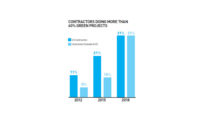
Research recently conducted by McGraw-Hill Construction among contractors working on school projects demonstrates strong growth in green education projects. To qualify for the study, contractors had to have completed new construction or major renovation or improvement projects at K–12 schools or higher-education institutions.
The Green-School Market
Of the more than 100 contractors that qualified for the study, 83% have done new or major-renovation green-school projects in the last three years, and 79% have done some green retrofits and operational improvements. During this period, the contractors performed a higher percentage of green new-construction and renovation work, with 22% of them reporting that 60% or more of their major new work is green, compared to only 11% reporting the same level of green retrofits and renovations.
However, as contractors forecast work for the next three years, the gap narrows between new or major-renovation projects and retrofit or operational projects. Over this period, 12% of the contractors are not expecting any new or major-renovation school projects, up from just 1%. The decline is likely due to concerns about state and local budget reductions.
Despite the reduced market, nearly all those firms expecting major school projects think at least some of them will be green, with only 3% not expecting to do green work, and a 5% growth in those who think the majority of their major school projects (over 60%) will be green. Contractors expect more robust green growth in retrofit and operational improvements at schools. Those who will not do any green-retrofit work declined from 17% to 6% between the last three years and the next three years. The survey shows a 50% growth in firms that expect most of their school retrofit and operational projects to be green, up from 11% to 17%.
While the gap narrowed only slightly between the percentage of green construction in major projects versus minor retrofits, it suggests a broader approach toward green schools that includes more minor projects. Contractors that can demonstrate their green skills in these smaller projects may have an advantage in this still-evolving market, the study shows.
Key Drivers
Research conducted by McGraw-Hill Construction also included a direct survey of the K–12 and higher-education sectors and analysis of factors that led owners to build green. This sector places a high value on green building to improve health and well-being.
In fact, 89% of K–12 respondents say health and well-being is an important factor encouraging them to build green, nearly as many as targeted reduced energy use (93%) and operating-cost savings (90%). Improved indoor air quality is also important across the education sector, with well over 80% of firms citing it as a important reason for building green.
These factors have also been growing over the last five years. In 2007, members of the Council of Education Facility Planners International were surveyed about green-school catalysts, and several respondents in the 2012 survey also were CEFPI members. This allows for direct analysis of how green schools changed during the recession and its impact on school construction. More contractors with a higher level of green-schools experience report measurable benefits for building owners. The more challenging a factor, the more experience counts in finding its benefits.
The importance of health and well-being has been growing over the last five years. In 2007, 61% of members of the Council of Education Facility Planners International (CEFPI) surveyed found this to be an important catalyst for green school projects, compared to 79% of CEFPI members included in the 2012 survey, demonstrating the increasing impact of this factor on green school construction.
Therefore, reduced energy use, a relatively straightforward measure of green building performance, is observed by close to the same percentage of contractors doing a medium level of green work (16% to 60% of projects) and those doing a high level of green work (more than 60% of projects), but both are considerably higher than contractors that do only a low level (1% to 15%) of green projects.
However, annual operating savings, a more involved measure of green, is reported by a notably larger percentage of those doing a high level of green projects than of those doing a medium level.
The impact of the level of green work is supported by contractors' awareness of green products and practices. For example, in the green-schools sector, the impact of improved acoustics is more noticeable than in other green-building sectors. Contractors working on green schools may have limited control over how acoustics are incorporated into the design. That means less difference can be expected in these features on projects by contractors that do many green projects than on ones by those who only do a few.
However, 79% of contractors with a medium or high level of green projects report improved acoustical elements compared to just 45% of those with a low level of involvement. This demonstrates that contractors who do more green work are also better informed about green practices on their projects, which provides them an advantage as the sustainable schools market continues to expand.
Green construction is already prominent in the education sector, and it will continue to grow over the next few years. Contractors that seek to be competitive will need to capitalize on green expertise and demonstrate that they can build sustainably.
For more information on green schools, get a free download of the SmartMarket Report on "New and Retrofit Green Schools: The Cost Benefits and Influence of a Green School on its Occupants" at www.construction.com/market_research.



Post a comment to this article
Report Abusive Comment